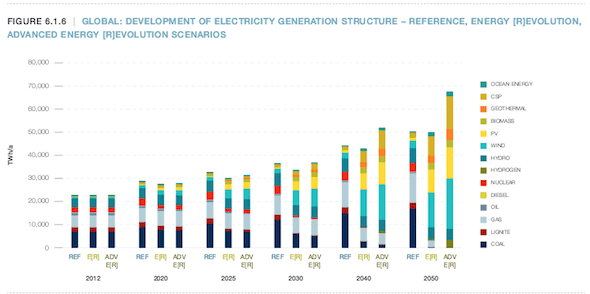Whether or not last week’s unceremonious changing of the guard in Canberra will shift Australia’s political debate on renewables from bickering over costs, to developing sensible policy for growth, remains to be seen.
But a new report released by Greenpeace International on Monday has reinforced the view that there are no major economic or technical barriers to shifting the world to 100 per cent renewable energy by 2050; nor to the complete phase-out of fossil fuels. All we need now is the political will to do it.
Greenpeace’s Energy [R]evolution scenario 2015 phases out coal, oil, gas and nuclear energy as fast as technically and economically possible, by expanding the renewable energy share to 42 per cent in 2030, 72 per cent in 2040 and 100 per cent in 2050.

The only remaining use for fossil fuels, says the report, would be in the non-energy sector, such as petrochemicals and steel making.
Of course, the transition will not come cheaply. As you can see in the chart below, there is a lot to be done, and according to, the costs will be “huge” at around $US1 trillion a year. But the analysis also shows that the savings are even bigger.

“The investment costs for the switch to 100% renewables by 2050 is about $US1 trillion a year,” the report says.
“But because renewable energies don’t need fuel, the average fuel cost savings are $US1.07 trillion a year. So the investment over the period is met in full (107 per cent) by fuel cost savings, with the cross-over happening between 2025 and 2030.
Beyond 2050, there are no further fuel costs in renewable energy, thus stabilising energy costs for socities, as well as reducing energy sector emissions to near zero.
So it is not only achievable by 2050, according to Greenpeace’s analysis, but affordable, cost competitive, a net job creator and would bring a huge cut in global emissions.
You can see in the table below how this plays out under Greenpeace’s scenario, as compared to the International Energy Agency’s “Current Policies” scenario.

A large part of the report focuses on the global power generation sector, which it notes has been the most dynamic, with a renewables comprising 60 per cent of new generation world wide in 2014, despite energy subsidies still being “weighted heavily in favour of fossil fuels.”
According to the report, the transformation to a carbon free 100% renewable energy system in the Advanced Energy [R]evolution scenario – Greenpeace’s optimum scenario – will increase global electricity demand in 2050
to more than 40,000 TWh/a from about 18,860 TWh/a in 2012.
“Electricity will become the major renewable ‘primary’ energy, not only for direct use for various purposes but also for the generation of synthetic fuels for fossil fuels substitution,” says the report.
Around 8,100 TWh are used in 2050 for electric vehicles and rail transport, around 5,100 TWh for hydrogen and 3,600 TWh for synthetic liquid fuel generation for the transport sector.
The report notes that the transition from fossil fuels to renewable electricity – either directly or via synthetic fuels – for the entire global transport sector “is one of the most difficult parts of the Energy [R]evolution and requires a true technical revolution.
“It is ambitious but nevertheless possible with currently available technologies for land-based and other transport,” the report says.


It also finds that more jobs would be created in the energy sector by this shift – with
the solar industry alone employing as many people in the future as the coal industry does today.
According to the data, the solar PV industry would employ 9.7 million people by 2030, more than 10 times as many as it does today. Jobs in wind power would grow to 7.8 million over the same period.
The report also details the major changes that will have to take place in the world’s energy markets; mostly in the structure of its grids, as they shift from being centralised systems based on large baseload energy generation plants, to decentralised systems, making the most of multiple sources of rooftop solar, wind energy and large-scale solar, as well as geothermal and hydro.














